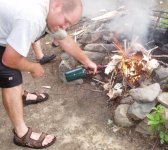The biggest "trick" I have is to take my time and do it right.... normal fire prep involves double handfuls each of pencil-lead, pencil, thumb, and wrist-sized wood. Rainy prep should be double that, triple if you have time.
I try to acquire a good stash of birchbark, and once you get it going, it can help dry your other "tinder", which I usually get in the form of spruce twigs and branches... these are often damp when everything else is wet, but they still burn well, and better than most other damp tinders. Sometimes you can cut the bark off and it's drier underneath. For the next bigger wood, 'thumb sized", this is where split wood is handy, and I try really hard to find something in the way of a dead maple (I mentioned in an earlier post preferring to set up under a plowpoint tarp, and putting up a few days worth of wood on the first afternoon. This pays off in that you seldom have to start a fire in the rain that way. But I understand that you still need to be able to do it well.)
A sheet of birchbark held up over two (or even 1) stakes to provide rain cover will help, as will starting the tinder on a sheet of bark or a split piece of wood to keep it up off the wet ground. A sit pad works too, but you have to be careful not to melt it... a sit pad also works well to fan your young fire.
Fatwood (lighter pine, whatever you want to call it) is also excellent as a tinder. now that I'm back north, I tend to use birchbark, but down south, or where pine is prevalent, fatwood is solid turpentine and burns well. I used to lay a piece of newspaper in the bottom of my table saw dust catcher. Then i'd run a couple pieces of fatwood through, collecting the dust. I'd carry it in a mini Altoids Tin, the little 1.5" x 2.5" kind, and it would start with the scrape of a firesteel. Not a huge firesteel fan though, because a flame will start coarser/worse tinder. Using one is a skill worth learning, but I prefer my Bics or matches.
The driest wood is found under pines, on the lee side of the weather, next to cliffs or rocks that shielded it from rain, and inside broken trees/limbs. Sometimes all you have to do is scrape off the wet bark. Other times, you have to look harder, and still other times, you have no choice but to make shavings and fuzz sticks.
A heavy-duty ziplock bag is invaluable for collecting tinder and keeping it dry. You can leave the top open and tuck it into your shirt for safety.
For cheats, which I have no compunction doing when it's cold and I'm wet, I carry three very useful tools:
- One is a Bic lighter lanyarded to my left pocket... there is nothing like it, and cheaper variants are not acceptable. I swear by them (and actually carry several, large and small) in my repair kit, kitchen set, and pockets. I found one buried in a tank track mark in a military training area once... so long buried that it was rusty... but it worked after I cleaned it up. Anyway, I'm a big fan.
- Second is the fuel from whatever stove I'm carrying. I always have a small container of alcohol, if not gasoline, and sometimes butane, and these can help when nature is not cooperating. A splash of this on the tinder pile sometimes saves the day.
- Third, I always carry something fire-starterish, and sometimes more than one, depending on my gear set... there is at least 1 birthday candle in my repair kit. I have a piece or two of waxed jute twine about 2-3" long in my match container, which usually rides in a pocket. I usually have a couple waxed and sawdust-filled egg carton sections in the bottom of my food bag. And I have a tea light candle in the pocket of one of my anoraks (along with a lighter and space blanket, for a Palmer Furnace) if I'm wearing that. The best of the lot is the egg carton sections, which burn for about 5 minutes, and sometimes you need every bit of that to dry out the tinder above it.
Fire lay is important too... I've discovered that a teepee style fire is far superior in rain to a log cabin style... there's just something about the shape of that kind of 'firebox' that holds heat in, protects the center from the rain, and somehow works better.

